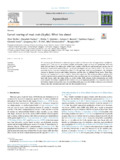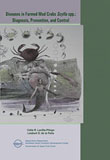Formalin as an alternative to trifluralin as prophylaxis against fungal infection in mud crab Scylla serrata (Forsskål) larvae
| dc.contributor.author | de Pedro, Jennette B. | |
| dc.contributor.author | Quinitio, Emilia T. | |
| dc.contributor.author | Parado-Estepa, Fe Dolores | |
| dc.date.accessioned | 2014-05-15T08:49:12Z | |
| dc.date.available | 2014-05-15T08:49:12Z | |
| dc.date.issued | 2007 | |
| dc.identifier.citation | de Pedro, J. B., Quinitio, E. T., & Parado-Estepa, F. D. (2007). Formalin as an alternative to trifluralin as prophylaxis against fungal infection in mud crab Scylla serrata (Forsskål) larvae. Aquaculture Research, 38(14), 1554-1562. | en |
| dc.identifier.issn | 1355-557X | |
| dc.identifier.uri | http://hdl.handle.net/10862/2058 | |
| dc.description.abstract | The toxicity of formalin and trifluralin to the larval stages of the mud crab Scylla serrata was compared in a static bioassay. Prophylactic doses of 5, 10, 15, 20 and 25 μg L−1 formalin and 0.05, 0.1, 0.2, 0.4 and 0.8 μg L−1 trifluralin were used. Toxicity was assessed on the basis of survival of larvae after 24, 48, 72 and 96 h exposure to the test chemicals and metamorphosis to the next larval stage. Result shows that larval survival in all stages was significantly reduced at concentrations of 20 and 25 μg L−1 formalin whereas larvae were able to tolerate all trifluralin treatments. However, larvae became more tolerant to high formalin concentrations as the larval stage progressed. Survival was better at 5, 10 and 15 μg L−1 formalin and in all trifluralin treatments than the control in almost all the larval stages. Faster metamorphosis was observed at 5 and 10 μg L−1 formalin and 0.05, 0.1 and 0.2 μg L−1 trifluralin concentrations. Doses of formalin and trifluralin obtained from the toxicity experiments were applied as prophylaxis to newly hatched larvae in white plastic basins. Prophylactic doses of 5 and 10 μg L−1 formalin and 0.05 and 0.1 μg L−1 trifluralin applied every other day were found to be effective in enhancing survival and larval development to megalopa compared with control. However, no megalopae survived to crab instar in all formalin treatments. Although the use of fungicides in rearing systems resulted in higher survival compared with controls, other strategies (i.e. maintenance of good water quality and hygienic practices in the hatchery) should be further investigated as an alternative to the use of chemicals in hatcheries. | en |
| dc.language.iso | en | en |
| dc.publisher | Blackwell Publishing | en |
| dc.subject | Decapoda | en |
| dc.subject | Scylla serrata | en |
| dc.title | Formalin as an alternative to trifluralin as prophylaxis against fungal infection in mud crab Scylla serrata (Forsskål) larvae | en |
| dc.type | Article | en |
| dc.identifier.doi | 10.1111/j.1365-2109.2007.01723.x | |
| dc.citation.volume | 38 | |
| dc.citation.issue | 14 | |
| dc.citation.spage | 1554 | |
| dc.citation.epage | 1562 | |
| dc.citation.journalTitle | Aquaculture Research | en |
| seafdecaqd.databank.controlnumber | 2007-23 | |
| dc.subject.asfa | bottom culture | en |
| dc.subject.asfa | crustacean culture | en |
| dc.subject.asfa | disease control | en |
| dc.subject.asfa | larvae | en |
| dc.subject.asfa | life cycle | en |
| dc.subject.asfa | metamorphosis | en |
| dc.subject.asfa | disease prophylaxis | en |
| dc.subject.asfa | toxicity | en |
| dc.subject.asfa | water quality | en |
| dc.identifier.essn | 1365-2109 | |
| dc.subject.scientificName | Scylla serrata | en |
このアイテムのファイル
| ファイル | サイズ | フォーマット | 閲覧 |
|---|---|---|---|
|
このアイテムに関連するファイルは存在しません。 |
|||
このアイテムは次のコレクションに所属しています
-
Journal Articles [1256]
These papers were contributed by Department staff to various national and international journals.



